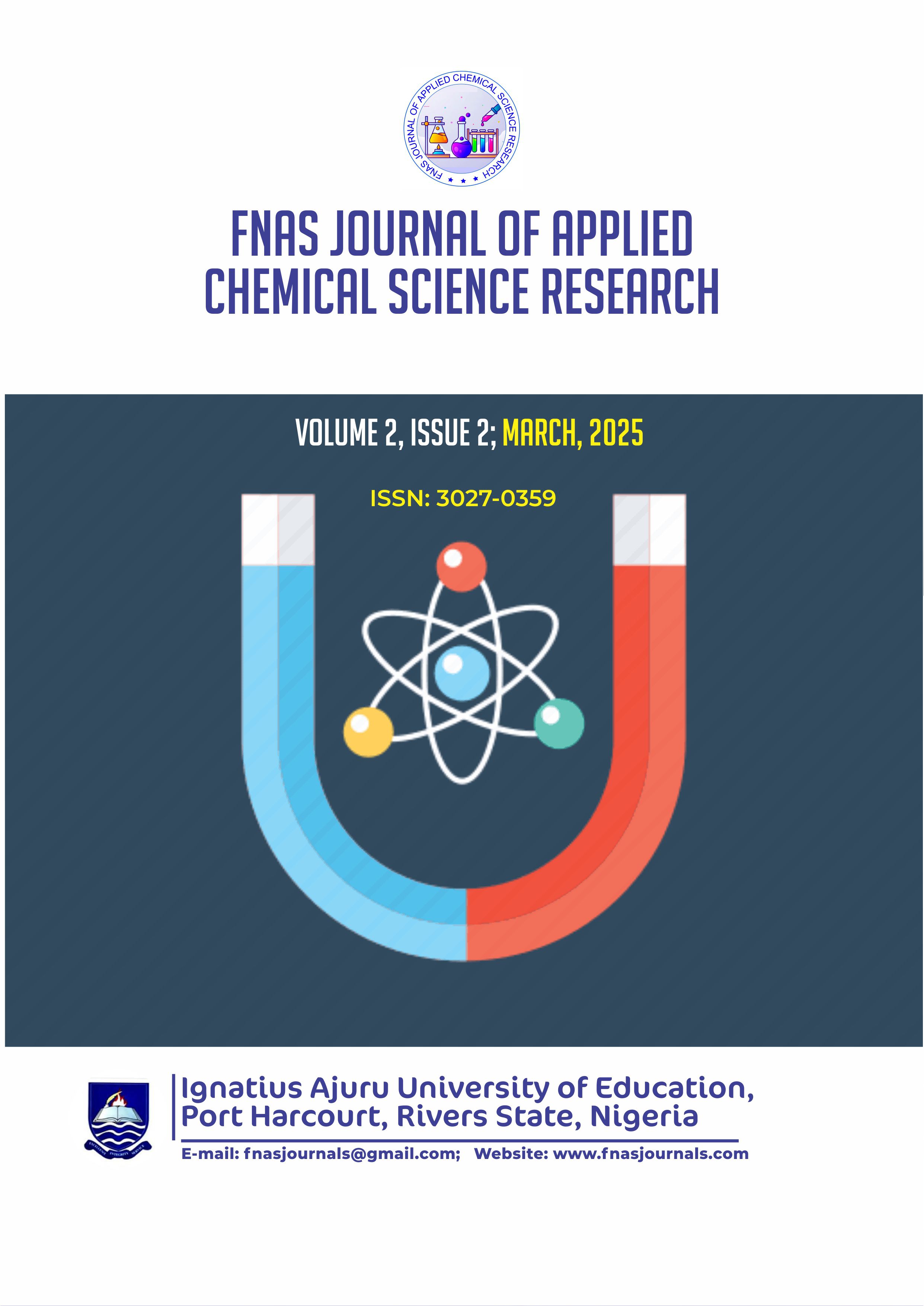Phytochemical and Proximate Analysis of Wild Fruits and Vegetables from the Federal Capital Territory, Abuja
Keywords:
Phytochemical Analysis, Proximate Analysis, Wild Fruits, Wild Vegetables, Nutritional CompositionAbstract
Over the ages, fruits and vegetables have always been an important part of both human and animal diets. Fruits and plants in general have several medicinal and therapeutic uses in addition to being a source of food to satisfy dietary needs. Little to no attention has been paid to the nutritional value of the many fruits and leafy vegetables that are growing unchecked in the Six Area Council of the Federal Capital Territory (FCT). Documenting the nutritional value of these wild fruits and vegetables would be helpful in the food-based strategy to eliminate micronutrient deficiencies. Therefore, the study's objective is to assess the ethnomedical applications, phytochemical components, and proximate analysis of lesser-known wild fruits and vegetables that are consumed in the FCT, Abuja. The result revealed that in wild vegetables, seven parameters were examined. While Physalis angulata had the lowest dry matter (50.28%) and carbohydrate (3.23%), Portulaca oleracea had the highest dry matter (95.27%) and carbohydrate (73.32%). Vitex doniana had the lowest protein (1.01%), while Cyathea postiato had the greatest crude protein (9.24%), fat (7.03%), and fibre (46.70%). Ash concentration was highest in Celosia isertii (16.67%), moisture content was highest in Solanum dulcamara (15.55%), and lowest in Portulaca oleracea (4.73%). Phytochemical screening of 17 wild vegetables revealed varying presence of alkaloids, carbohydrates, flavonoids, glycosides, phenols, saponins, steroids, tannins, and terpenoids, with some compounds absent in specific vegetables. In conclusion, vegetables that are high in protein, fibre, and carbohydrates are valuable for food security. They also have phytochemical components that may be used therapeutically to treat microbial infections, inflammation, and oxidative stress.
References
Achikanu, C. E., Ani, O. N., & Onyishi, C. K. (2020). Proximate, phytochemical and vitamins compositions of Cucumis metuliferus (horned melon) rind. Journal of Complementary and Alternative Medical Research, 9, 40–50.
Adewusi, S. R. A., Olayemi, F. F., & Ojokoh, A. O. (2020). Nutritional composition of selected wild vegetables in Nigeria. Journal of Food Science and Nutrition, 8(2), 134–145.
Ajayi, T. O., Adegbite, A. A., & Salau, R. B. (2022). Lipid and protein composition of some Nigerian leafy vegetables. Nigerian Journal of Nutritional Science, 4(1), 44–52.
Akinmoladun, F. O., Olaleye, T. M., & Komolafe, O. T. (2019). Phytochemicals and their pharmacological relevance in indigenous Nigerian vegetables. African Journal of Biochemistry Research, 13(1), 25–39.
AOAC. (2020). Official methods analysis (21st ed.). Association of Official Analytical Chemists., Appendix D, AOAC INTERNATIONAL, Rockville, MD, http://www.eoma.aoac.org/app_d.pdf
AOAC. (2022). Official methods analysis (21st ed.). Association of Official Analytical Chemists.
Bvenura, C., & Sivakumar, D. (2017). The role of wild fruits and vegetables in delivering a balanced and healthy diet. Food Research International, 99, 15–30.
Dutta, C., Yadav, D. K., Arora, V. K., & Malakar, S. (2023). Drying characteristics and quality analysis of pre-treated turmeric (Curcuma longa) using evacuated tube solar dryer with and without thermal energy storage. Solar Energy, 251, 392–403.
Ekpo, U. E., & Udoh, F. T. (2020). Ash and mineral content of wild and cultivated vegetables in Nigeria. International Journal of Agricultural Science and Food Technology, 6(4), 102–110.
Ene-Obong, H. N., Ekpo, J. O., & Igile, G. O. (2018). Dietary fiber composition of traditional leafy vegetables in Nigeria. International Journal of Food Properties, 21(3), 567–580.
Igwe, C. U., Okwuonu, V. C., & Madu, J. N. (2021). Antioxidant and anti-inflammatory effects of flavonoids in selected vegetables. Journal of Medicinal Plants Research, 15(7), 122–131.
Kiani, A. K., Dhuli, K., Donato, K., Aquilanti, B., Velluti, V., Matera, G., ... & Bertelli, M. (2022). Main nutritional deficiencies. Journal of Preventive Medicine and Hygiene, 63(2 Suppl 3), E93.
Lawal, A. M., Lawan, M. M., & Apampa, S. A. (2019). Phytochemical analysis and thin layer chromatography profiling of crude extract from Guiera senegalensis (leaves). Journal of Biotechnology and Biomedical Science, 3(3), 7–12.
Mandev, J. S., Wolayan, F. R., Pontoh, C. J., & Sondakh, B. F. J. (2019). Phytochemical characterization of cucumber seeds as candidate of water additive for organic broiler chickens. Journal of Advanced Agricultural Technologies, 6, 61–64. https://doi.org/10.18178/joaat.6.1.61-64
Odukoya, O. A., Afolabi, I. S., & Oladapo, A. A. (2019). Nutritional and functional properties of wild edible vegetables. African Journal of Food Science and Technology, 10(3), 234–246.
Ogundele, O. M., Adebayo, J. O., & Fajobi, T. A. (2019). Phenolic compounds in Nigerian vegetables and their health benefits. International Journal of Phytotherapy Research, 9(2), 78–89.
Oni, T. O., Oke, O. A., & Adebayo, B. T. (2021). Protein content and amino acid profile of Nigerian leafy vegetables. African Journal of Agricultural Research, 16(5), 142–153.
Pandey, K.B., Rizvi, S.I (2009). Plant polyphenols as dietary antioxidant in human health and diseases. Oxid. Med.Cell Longev. 2,270-278.
Sahoo, H.B., Sahoo, S.K., Mishra, K., & Sagar, R. (2015). Evaluation of the wound healing potential of Amaranthus viridis leaves in diabetic rats. International Journal of Nutrition, Pharmacology Neurological Diseases.
Ukwubile, C. A., Olowokere, T. A., & Olarinde, O. O. (2020). Terpenoids and their pharmacological significance in African leafy vegetables. Journal of Herbal Medicine and Toxicology, 14(1), 97–108.
Umar, F. H., Hassan F. H., Haruna, B., Dalhatu, A. L., Halima, F. H., Dahiru, A. J., Ahmad, M.S., Kamaluddeen, L. S., Usman, B., Khuzaifa, Y. M., Rofiyat K. A. (2020). Feed quality potentials of the aerial parts of Amaranthus spinosus. Chemistry Research Journal, 2020, 5(6): 29-36.
Zhincheng, y., Fengping, G., Yuqing, Z., Litong, R., Yirong Zeng. (2024). Elucidating Cyathula Officinals’ mechanism in oesteoarthrithis treatment: Network pharmarcology and empirical evidence on anti-inflamatory actions. https:doi.org/10.1016/j.heliyon.2024.e27999.


